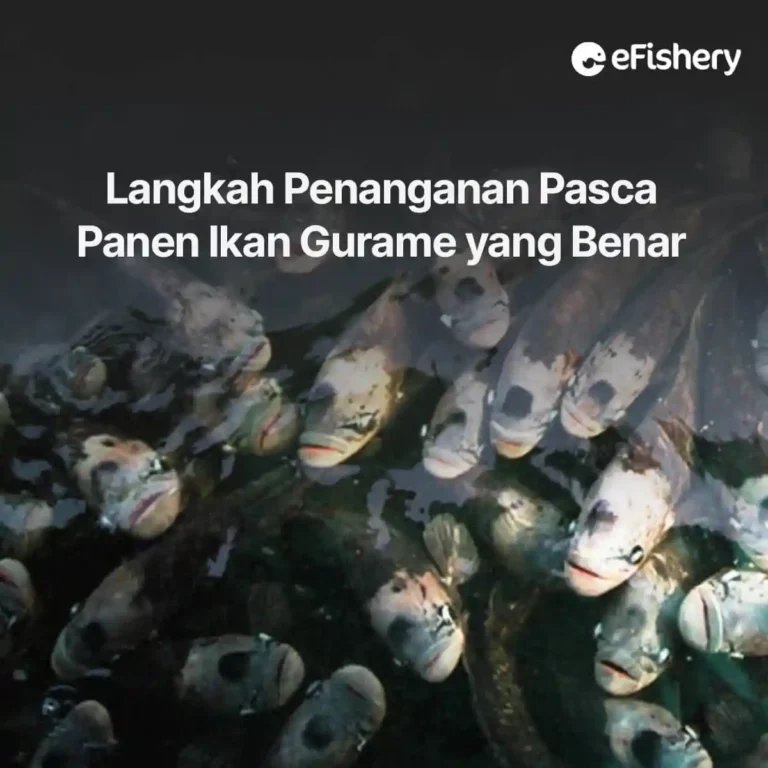Panen ikan gurame adalah salah satu rangkaian akhir dalam budidaya ikan gurame. Namun, sebelum ikan sampai ke pembeli, ikan harus ditangani sedemikian rupa agar kondisinya tetap prima. Maka dari itu, setelah masa panen ikan gurame selesai, ada yang dinamakan proses penanganan pasca panen ikan gurame.
Want to know what it looks like? Read this article to the end!
Post-Harvest Handling of Gurame Fish
Before knowing the steps for handling post-harvest carp, it is better if you know how to harvest carp in advance. The ideal age for harvesting carp is 8-12 months with a body weight of 0.7-1 kg. After the fish reach their ideal weight, here are the things you need to pay attention to when harvesting:
- Prepare a fine net when harvesting so as not to damage the fish fins.
- Install drains to prevent wasted fish.
- Place nets all over the pond to catch fish.
- Reduce the water in the pool gradually.
- Catch the fish carefully, use your hands as an alternative to catching fish.
- Place the caught fish in a separate container filled with clean water.
- Move or transport the fish to the shelter using a container filled with water.
After the fish have been harvested and transferred to the shelter, you can start handling the post-harvest carp. However, at this stage fish are divided into 2 categories, namely live fish and fresh fish. The two categories of fish have different handling. Here are the steps:
1. Steps for Handling Live Fish
Compared to handling fresh carp, the steps for handling live carp require extra caution. This is because the carp must remain alive when it reaches the consumer. Even so, live carp has a higher selling price than fresh carp.
In order for carp to reach consumers alive and healthy, use the following methods:
- Use low temperature water (about 20°C) during the transport process.
- Avoid high density of carp in the carrier.
- Separate fish according to size
- Carry out the transport in the morning or evening.
- Keep the temperature stable during the transportation process so that the carp are not stressed by using crushed ice cubes that are provided around the transportation area.
- Pack the fish when the transport car is ready to go to avoid stress on the fish. Don't pack the fish if it's still a long time to leave.
2. Ways of Handling Fresh Fish
When it is not in a living condition, the quality of the carp will quickly decrease if it is not handled properly. Bad smell, no longer red gills, and mushy meat texture are some of the characteristics of carp whose quality is no longer prime. For this reason, you must maintain the quality of fresh carp so that the fish can be easily sold to consumers.
To maintain the freshness of the carp, do the following:
- Wash the carp thoroughly so that there is no slime and dirt that sticks when it is packaged.
- Use a clean, closed transport container. Short distance transportation (2 hours journey) can use baskets lined with banana leaves or plastic. Meanwhile, long-distance transportation can use zinc-plated boxes or fiberglass with a maximum capacity of 50 kg if the maximum box height is 50 cm.
- Place the crushed ice (1:1 ratio of ice and fish) into the packing box until the temperature is 6-7°C. Ice is placed on the bottom of the box 4-5 cm thick, on top of each layer of fish 5-10 cm thick, and on the walls of the box 5 cm thick.
Methods of Transporting Gurame Fish Harvest
During the transportation process, the carp will be more susceptible to stress. This can be caused by many things, one of which is shock during the trip and changes in temperature during the trip. To transport carp properly, follow these steps:
- Carry out the transport at night, because the air temperature is cooler.
- Use a plastic drum volume of 200 liters with a maximum density of 20 kg of carp for live carp.
- Prepare oxygen to be carried in the transport car.
- Do not take too long in preparing the load.
- Park the car carrier close to the cultivation location so that the process of putting fish in the car is easier.
- Gurame fish may only be taken for a journey of a maximum of 6 hours to maintain the quality of the fish.
- Use a pickup or convertible to transport fish to make it easier to regulate the temperature of the water on the way.
- Cover the car with a tarpaulin.
- Provide a cover on the tailgate to secure the fish, avoid fish theft, and prevent fish from jumping during the trip.
- Finally, do a final check before the trip to ensure the safety of transportation.
Kembangkan Budidaya Gurame Setelah Panen dengan Kabayan!
Setelah melakukan pemanenan ikan gurame dari siklus budidaya terdahulu, saatnya Bapak/Ibu memulai siklus budidaya baru dengan memperbesar skalanya pakai Kabayan. Kabayan (Kasih, Bayar Nanti) merupakan penyedia akses ke institusi finansial terpercaya serta diawasi/berizin OJK untuk membeli pakan. Bapak/Ibu bisa mendapatkan pakan berkualitas dengan sistem pembayaran tempo yang dapat dibayarkan setelah panen. Dengan proses cepat dan persyaratan mudah, budidaya ikan pun makin lancar pakai Kabayan.
Isi formulir di bawah ini untuk mendapatkan akses ke Kabayan!
Get Access to Financial Institutions that are Trusted, Registered & Supervised by OJK!
Fill in your personal data in the following form. Our team will immediately contact you via the number cellphone attached. Make sure the data entered is correct.
- https://id.wikihow.com/Mengangkut-Ikan
- https://titikdua.net/panen-ikan-gurame/
- http://argomino.blogspot.com/2008/09/ka-diskanla-prop-diy-dan-ka-dipertalaut.html
